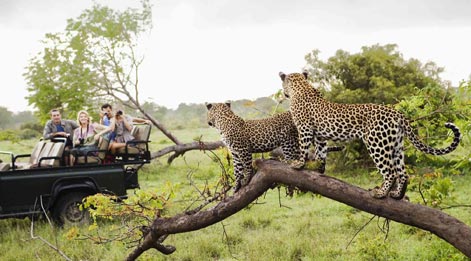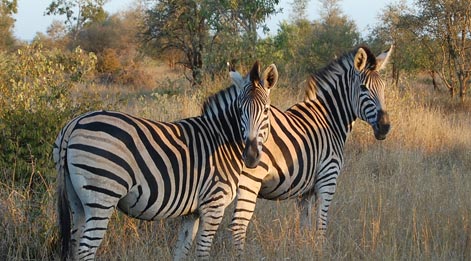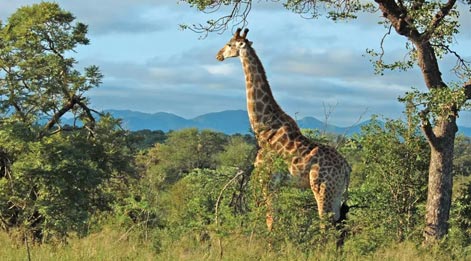Embarking on a wildlife safari in any African country is an experience unlike any other. Each country's unique landscape and wildlife offer endless opportunities for adventure and exploration. In Kenya's Maasai Mara, visitors can witness the Great Wildebeest Migration, where millions of wildebeest and zebras cross the Mara River, while in Tanzania's Serengeti, they can observe the iconic big cats and witness the annual wildebeest calving season. In South Africa's Kruger National Park, visitors can spot the Big 5 and learn about the region's fascinating cultural history.
Kruger National Park, South Africa

Kruger National Park is the largest and the first national park to establish in South Africa, occupying an area of 19,458 sq km. It is recognized as the Ambassador Park of South Africa and provides access through nine gates due to its vast expanse. The self-guided safari drives are popular among visitors, as the park has paved roads that are easy to navigate. However, it can be challenging to spot wildlife while driving. The park is part of the Great Limpopo Transfrontier Park, a collaborative effort between Zimbabwe and Mozambique that includes Gonarezhour National Park and Limpopo National Park. The three parks create the largest protected area in Africa, and travellers can spend several days experiencing the abundant wildlife. UNESCO recognizes Kruger National Park as part of the Kruger to Canyons Biosphere.
It features four key vegetation areas and has elevation changes ranging from 200 m to the highest point at 2,760 840 m, known as Khandzalive. Six rivers flow through the park, including Sable, Olifants, Crocodile, Letaba, Luvuvhu, and the Limpopo River. Kruger is home to more than 147 species of large mammals, the largest number in any game reserve. With approximately 517 species of birds and 114 species of reptiles, including black mambas, rock pythons, and crocodiles, bird lovers and reptile enthusiasts will also enjoy this park.
Undoubtedly, taking a safari through Kruger National Park is the quintessential experience for any visitor. The park boasts one of the most exotic assortments of wildlife on the African continent, making it a prime destination for safari enthusiasts. Regarded as the premier safari destination in southern Africa, Kruger is known worldwide as the most distinguished national park on the continent, attracting visitors from all corners of the globe. The park's unspoiled wilderness and diverse wildlife offer a memorable and awe-inspiring experience with nature that one will never forget.
Entrance Gates and Tines at Kruger National Park
1. Northern Kruger Park Gates
2. Central Kruger Park Gates
3. Kruger Park Southern Gates
Entry Time for Entrance Gates
Entry Time for Camp Gates
Exit Time for Camp Gates
Wildlife of Kruger National Park
Kruger National Park is renowned for its wildlife diversity, density, and abundance. The park is home to Africa’s entire iconic safari species, including the Big Five, as well as a supporting cast of 137 other mammals and over 500 varieties of birds. Visitors can witness the dramatic lives of these animals, and spot a variety of other species such as Reedbuck, Kudu, Zebra, Wild dog, and Spotted Hyena among the 200 different species found at Sabi Sands. The reserve has gained fame for its Leopard conservation project, which is an added attraction for visitors.


If planning a wildlife viewing trip to Kruger Park, it's best to schedule it during the dry months of June to September when the vegetation is less dense. Amongst these months, August to September is a highly recommended time as the temperatures are warmer than those in mid-winter and the animals tend to gather around water sources, creating an excellent opportunity for game viewing. Animals that are commonly sighted at Kruger include elephants, giraffes, zebras, buffalo, wildebeest, hyenas, etc. whereas animals like hippos, leopards, cheetahs, lions, wild dogs, white rhinos and black rhinos are listed under rare and occasional sighting.
Birds of Kruger - Bird watchers visit Kruger to primarily look forward to the big 6 avifauna species - Kori Bustard, Saddle-billed Stork, Lappet-faced Vulture, Martial Eagle, Pel’s Fishing-Owl and Ground Hornbill. Other bird species that mark their presence are Starlings, Rollers, Vultures and Shrikes and Bee-eaters. Vultures are very common inhabitants of Kruger and their species include Martial, African Fish, African Hawk, Tawny, Bateleur, Brown Snake eagle, Black-chested Eagle, etc. Bird watching is a popular activity at Kruger National Park, as the park has several water points that attract a diverse range of bird species. In addition, bird enthusiasts can also enjoy watching birds at the rest camps and picnic sites, which offer excellent birding opportunities.
Cultural Heritage of Kruger National Park
Kruger National Park is often associated with its impressive wildlife and vast wilderness, but it also has a rich cultural and historical landscape. The park boasts over 255 recorded archaeological sites, spanning from the early Stone Age over a million years ago to various Iron Age settlements and more recent historical buildings and sites. Many of these sites hold significant cultural and spiritual value, while others reveal fascinating historical narratives of the area.
Some of these sites are open to the public, providing visitors with an opportunity to learn and appreciate the diverse cultural heritage of the park. They are -
- Albasini Ruins
- Masorini Ruins
- Thulamela
Climate
Dry Season (April to September)From April to September, the winter months are delightful, featuring warm, dry days and cold nights. During this period, wildlife sightings are generally optimal since the sparse vegetation and restricted water sources, limited to rivers and watering holes, make it easier to spot animals. If you plan on going on night drives, make sure to bring warm clothing to keep yourself comfortable.
Rainy Season (October to March)In this region, the summers are hot and rainy, commencing from October and ceasing around March. The park, which is usually arid, is transformed into a luxuriant blooming paradise by the summer rains. However, the dense foliage created by the increased vegetation can sometimes make it difficult to spot animals.
Best Time to Visit Kruger Kruger National Park is a year-round destination that offers visitors unique experiences in every season. While the dry winter months are ideal for game viewing, the lush bushveld and full waterholes during the wet summer season attract many newborn animals and summer migrant birds. With a hot, sub-tropical climate, most of the year is warm during the day, generally above 25°C, making it a perfect destination to visit any time of the year.
Summer During the summer season, Kruger Park experiences rainfall which fills up the rivers and waterholes, making the bushveld look lush and beautiful. However, game viewing may become a bit challenging during this time due to the dense vegetation that makes it difficult to locate and observe wildlife. The end of November and early December is a great time to spot young beasts in Kruger National Park, which adds to the memorable Kruger Park safari experience of spotting wildlife with their young. The arrival of summer migrant birds makes birding an excellent activity during this time. If you're planning to visit Kruger Park during the summer season, it is recommended to travel in an air-conditioned vehicle and stay in air-conditioned accommodation.
Winter The perfect time to observe African wildlife in Kruger National Park is during the dry winter season. During this time, the bushveld is sparser, resulting in better visibility. The grass is low, and the bushes and trees are less leafy, thus allowing wildlife to migrate towards the water sources since there is no rain. As a result, water holes, dams, and rivers become more active, and you are more likely to see animals coming for a drink in the early morning and evening. Winter temperatures are moderate during the day, but it can get quite chilly at night, so make sure you bring some warm clothing when going on afternoon or night game drives.
Why travel with us?
Recent reviews from travellers who planned and booked their Africa trips with GTI Travels Pvt. Ltd.

“Our group had an incredible time during the safari tours with an excellent tour guide. GTI Travels provides incomparable services, highly recommended for anyone looking to embark on exciting African wildlife safaris.”
Review


“We had a dream come true experience during our African safari as we saw all the big 5 with the help of an excellent guide who was always attentive and knowledgeable.”
Review


“Our experience was great with excellent communication and a well-crafted tour package resulting in a smooth trip. The tour operator's prompt response efficiently scheduled our stays and flights.”
Review



